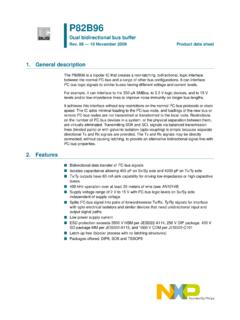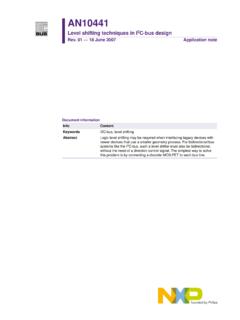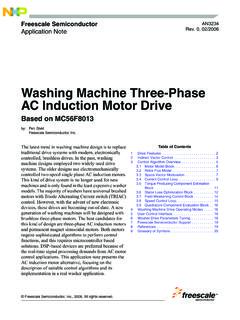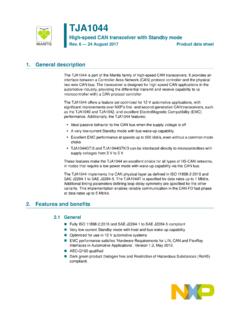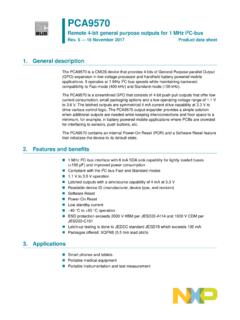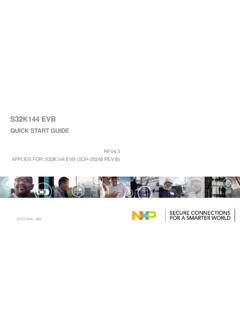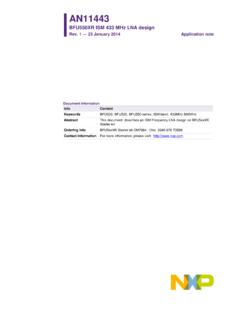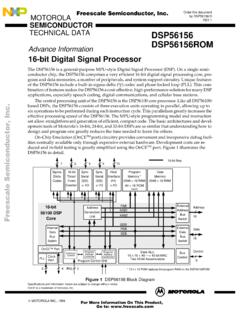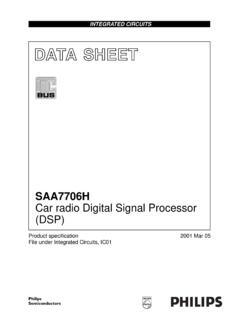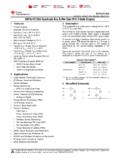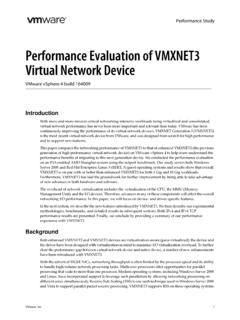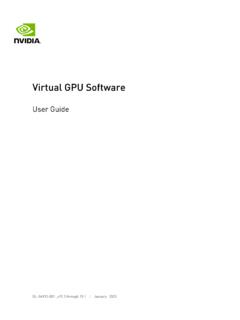Transcription of PCA9511A Hot swappable I2C-bus and SMBus bus buffer
1 1. General descriptionThe PCA9511A is a hot swappable I2C-bus and SMBus buffer that allows I/O cardinsertion into a live backplane without corrupting the data and clock buses. Controlcircuitry prevents the backplane from being connected to the card until a stop command orbus idle occurs on the backplane without bus contention on the card. When theconnection is made, the PCA9511A provides bidirectional buffering, keeping thebackplane and card capacitances PCA9511A rise time accelerator circuitry allows the use of weaker DC pull-upcurrents while still meeting rise time requirements. The PCA9511A incorporates a digitalENABLE input pin, which enables the device when asserted HIGH and forces the deviceinto a low current mode when asserted LOW, and an open-drain READY output pin, whichindicates that the backplane and card sides are connected together (HIGH) or not (LOW).During insertion, the PCA9511A SDA and SCL lines are precharged to 1 V to minimizethe current required to charge the parasitic capacitance of the FeaturesnBidirectional buffer for SDA and SCL lines increases fan out and prevents SDA andSCL corruption during live board insertion and removal from multipoint backplanesystemsnCompatible with I2C-bus Standard-mode, I2C-bus Fast-mode, and SMBus standardsnBuilt-in V/ t rise time accelerators on all SDA and SCL lines ( V threshold)requires the bus pull-up voltage and supply voltage (VCC) to be the samenActive HIGH ENABLE inputnActive HIGH READY open-drain outputnHigh-impedance SDA and SCL pins for VCC=0Vn1 V precharge on all SDA and SCL linesnSupporting clock stretching and multiple master arbitration/synchronizationnOperating power supply voltage range.
2 V to Vn0 Hz to 400 kHz clock frequencynESD protection exceeds 2000 V HBM per JESD22-A114, 200 V MM perJESD22-A115, and 1000 V CDM per JESD22-C101nLatch-up testing is done to JEDEC Standard JESD78 which exceeds 100 mAnPackages offered: SO8, TSSOP8 (MSOP8)PCA9511 AHot swappable I2C-bus and SMBus bus bufferRev. 04 19 August 2009 Product data sheetPCA9511A_4 NXP 2009. All rights data sheetRev. 04 19 August 20092 of 24 NXP SemiconductorsPCA9511 AHot swappable I2C-bus and SMBus bus buffer3. ApplicationsncPCI, VME, AdvancedTCA cards and other multipoint backplane cards that arerequired to be inserted or removed from an operating system4. Feature selection5. Ordering information[1]Also known as MSOP8 .Table selection chartFeaturePCA9510 APCA9511 APCA9512 APCA9513 APCA9514 Aidle detectyesyesyesyesyeshigh-impedance SDA, SCL pins for VCC= 0 Vyesyesyesyesyesrise time accelerator circuitry on SDAn and SCLn lines-yesyesyesyesrise time accelerator circuitry hardware disable pin forlightly loaded systems--yes--rise time accelerator threshold V versus Vimproves noise margin---yesyesready open-drain outputyesyes-yesyestwo VCCpins to support 5 V to V level translation withimproved noise margins--yes--1 V precharge on all SDA and SCL linesin onlyyesyes--92 A current source on SCLIN and SDAIN for PICMG applications---yes-Table informationTamb= 40 C to +85 CType numberTopsidemarkPackageNameDescriptionV ersionPCA9511 ADPA9511 ASO8plastic small outline package; 8 leads; body width mmSOT96-1 PCA9511 ADP9511 ATSSOP8[1]plastic thin shrink small outline package; 8 leads.
3 Body width 3 mmSOT505-1 PCA9511A_4 NXP 2009. All rights data sheetRev. 04 19 August 20093 of 24 NXP SemiconductorsPCA9511 AHot swappable I2C-bus and SMBus bus buffer6. Block diagramFig diagram of PCA9511A002aab580100 k RCH31 VOLTPRECHARGE100 k RCH4100 k RCH1100 k RCH2 CONNECTENABLEBACKPLANE-TO-CARDCONNECTION SLEW RATEDETECTORSLEW RATEDETECTORCONNECTCONNECT2 mA2 mABACKPLANE-TO-CARDCONNECTIONSLEW RATEDETECTORSLEW RATEDETECTORCONNECTCONNECT2 mA2 pFSCLOUTRDSQBUVLO20 ASTOP BIT ANDBUS sDELAYUVLOENABLESDAOUTVCCCONNECTCONNECTR EADYGNDPCA9511 APCA9511A_4 NXP 2009. All rights data sheetRev. 04 19 August 20094 of 24 NXP SemiconductorsPCA9511 AHot swappable I2C-bus and SMBus bus buffer7. Pinning Pin description8. Functional descriptionRefer toFigure 1 Block diagram of PCA9511A . Start-upAn undervoltage/initialization circuit holds the parts in a disconnected state whichpresents high-impedance to all SDA and SCL pins during power-up.
4 A LOW on theENABLE pin also forces the parts into the low current disconnected state when the ICC isessentially zero. As the power supply is brought up and the ENABLE is HIGH or the part ispowered and the ENABLE is taken from LOW to HIGH it enters an initialization statewhere the internal references are stabilized and the precharge circuit is enabled. At theend of the initialization state the Stop Bit And Bus Idle detect circuit is enabled. With theENABLE pin HIGH long enough to complete the initialization state (ten) and remainingHIGH when all the SDA and SCL pins have been HIGH for the bus idle time or when allpins are HIGH and a STOP condition is seen on the SDAIN and SCLIN pins, SDAIN isconnected to SDAOUT and SCLIN is connected to SCLOUT. The 1 V precharge circuitryFig configuration for SO8 Fig configuration for TSSOP8 ENABLEVCCSCLOUTSDAOUTSCLINSDAINGNDREADY0 02aab57712346587 PCA9511 ADPCA9511 ADPENABLEVCCSCLOUTSDAOUTSCLINSDAINGNDREA DY002aab57812346587 Table descriptionSymbolPinDescriptionENABLE1 Chip enable.
5 Grounding this input puts the part in a low current (< 1 A)mode. It also disables the rise time accelerators, isolates SDAIN fromSDAOUT and isolates SCLIN from clock output to and from the SCL bus on the cardSCLIN3serial clock input to and from the SCL bus on the backplaneGND4 Ground. Connect this pin to a ground plane for best output which pulls LOW when SDAIN and SCLIN aredisconnected from SDAOUT and SCLOUT, and goes HIGH when the twosides are connectedSDAIN6serial data input to and from the SDA bus on the backplaneSDAOUT7serial data output to and from the SDA bus on the cardVCC8power supplyPCA9511A_4 NXP 2009. All rights data sheetRev. 04 19 August 20095 of 24 NXP SemiconductorsPCA9511 AHot swappable I2C-bus and SMBus bus bufferis activated during the initialization and is deactivated when the connection is made. Theprecharge circuitry pulls up the SDA and SCL pins to 1 V through individual 100 k nominal resistors.
6 This precharges the pins to 1 V to minimize the worst casedisturbances that result from inserting a card into the backplane where the backplane andthe card are at opposite logic Connect circuitryOnce the connection circuitry is activated, the behavior of SDAIN and SDAOUT as well asSCLIN and SCLOUT become identical with each acting as a bidirectional buffer thatisolates the input capacitance from the output bus capacitance while communicating thelogic levels. A LOW forced on either SDAIN or SDAOUT will cause the other pin to bedriven to a LOW by the part. The same is also true for the SCL pins. Noise and VCC is generally ignored because a falling edge is only recognized when itfalls below with a slew rate of at least V/ s. When a falling edge is seen onone pin, the other pin in the pair turns on a pull-down driver that is referenced to a smallvoltage above the falling pin.
7 The driver will pull the pin down at a slew rate determined bythe driver and the load initially, because it does not start until the first falling pin is The first falling pin may have a fast or slow slew rate, if it is faster than the pulldown slew rate then the initial pull-down rate will continue. If the first falling pin has a slowslew rate then the second pin will be pulled down at its initial slew rate only until it is justabove the first pin voltage then they will both continue down at the slew rate of the both sides are LOW they will remain LOW until all the external drivers have stoppeddriving LOWs. If both sides are being driven LOW to the same value for instance, 10 mVby external drivers , which is the case for clock stretching and is typically the case foracknowledge, and one side external driver stops driving that pin will rise until the internaldriver pulls it down to the offset voltage.
8 When the last external driver stops driving aLOW, that pin will rise up and settle out just above the other pin as both rise together witha slew rate determined by the internal slew rate control and the RC time constant. As longas the slew rate is at least V/ s, when the pin voltage exceeds V for thePCA9511A, the rise time accelerator s circuits are turned on and the pull-down driver isturned Maximum number of devices in seriesEach buffer adds about V dynamic level offset at 25 C with the offset larger at highertemperatures. Maximum offset (Voffset) is V with a 10 k pull-up resistor. The LOWlevel at the signal origination end (master) is dependent upon the load and the onlyspecification point is that the I2C-bus specification of 3 mA will produce VOL< V,although if lightly loaded the VOLmay be ~ V. Assuming VOL= V and Voffset= V,the level after four buffers would be V, which is only about V below the threshold ofthe rising edge accelerator (about V).
9 With great care a system with four buffers maywork, but as the VOLmoves up from V, noise or bounces on the line will result in firingthe rising edge accelerator thus introducing false clock edges. Generally it isrecommended to limit the number of buffers in series to two, and to keep the load light tominimize the PCA9510A (rise time accelerator is permanently disabled) and the PCA9512A (risetime accelerator can be turned off) are a little different with the rise time accelerator turnedoff because the rise time accelerator will not pull the node up, but the same logic that turnsPCA9511A_4 NXP 2009. All rights data sheetRev. 04 19 August 20096 of 24 NXP SemiconductorsPCA9511 AHot swappable I2C-bus and SMBus bus bufferon the accelerator turns the pull-down off. If the VIL is above ~ V and a rising edge isdetected, the pull-down will turn off and will not turn back on until a falling edge a system with three buffers connected to a common node and communicationbetween the Master and Slave B that are connected at either end of buffer A and buffer Bin series as shown inFigure4.
10 Consider if the VOLat the input of buffer A is V and theVOL of Slave B (when acknowledging) is V with the direction changing from Master toSlave B and then from Slave B to Master. Before the direction change you would observeVILat the input of buffer A of V and its output, the common node, is ~ V. The outputof buffer B and buffer C would be ~ V, but Slave B is driving V, so the voltage atSlave B is V. The output of buffer C is ~ V. When the Master pull-down turns off, theinput of buffer A rises and so does its output, the common node, because it is the only partdriving the node. The common node will rise to V before buffer B s output turns on, ifthe pull-up is strong the node may bounce. If the bounce goes above the threshold for therising edge accelerator ~ V the accelerators on both buffer A and buffer C will firecontending with the output of buffer B. The node on the input of buffer A will go HIGH aswill the input node of buffer C.
